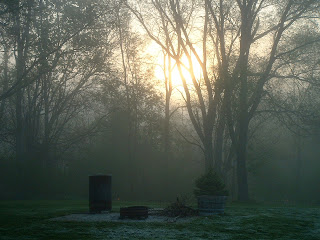The forester's full report will be some time coming – 60 days, he estimated, because he has to spend the next 30 installing gypsy moth traps. It sounds as though he lets his official paperwork pile up but stays current on email, so we can probably sooner get his notes and answers to specific questions that way.
Donna's emphasis was: "what's that thing; what's that called?" I asked him about enhancing wildlife, recreation, and timber values. He was very responsive to all that over the next two hours.
He encouraged redevelopment of the tractor trails and in particular suggested providing access to some of the old growth trees as park-type areas.
There are a lot of fruit trees of various kinds: cherry, plum, mulberry, boisenberry. There's a lot of gooseberry and raspberry. The shagbark hickory have edible nuts. He said there should be harvestable amounts of food from all these. We found a batch of morels. The trick, he said, is to look beneath an elm that has died in the last year or two.
Most of the little bushy type undergrowth is dogwood, which we can basically get rid of as much as we want because there's so much of it. It's excellent along edges for birds and wildlife but can be cut back in clearings to get more sunlight to the ground. But a lot of the bushy type things are also invasive honeysuckles and olives, which should probably go.
As for thinning overall, he said the rule is to look up and if a lower priority tree is into the branching structure of a higher priority tree, girdle or cut out the lower priority one. He really encouraged giving the old growth individuals their space, taking out basically any other trees within the drip line, but also making sure to leave some next-generation individuals of the same kind in the area. He thought some of the great trees were well into the two-hundreds years old.
He was very pleased at our interest in improving and managing the woodlands, in contrast. I got the impression, to many of his clients, and my guess is he'll probably give us as much additional service as we want. He had quite comprehensive knowledge about all that stuff. And he was truly nearly giddy by the time he left over the diversity and amount of native and high-value species – he said it was quite a remarkable property.
Some images from my walk down the lane to get the paper in this foggy morning sunrise:
The bottom terrace, toward The Narrows:
The pond:
Some images from my walk down the lane to get the paper in this foggy morning sunrise:
Siberian Elm:
Grandmother Cottonwood:
The pond:





No comments:
Post a Comment
I encourage and appreciate your comments, which I moderate to prevent spam – yours will be published shortly.